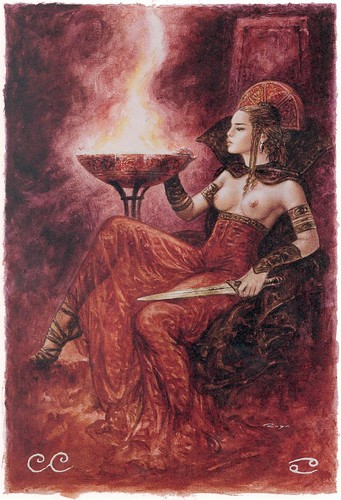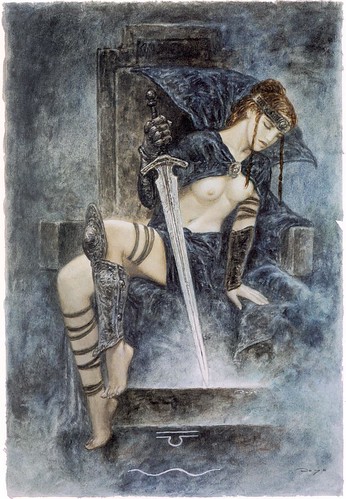



Elemental Dignities (known as EDs) determine the strength or weakness of cards when examined in pairs or triads based on whether the suit elements are friendly or contrary to each other. MacGregor Mathers, of the Hermetic Order of the Golden Dawn, was the first to describe this method of interpreting Tarot card combinations or interactions in a paper known as Book “T” – The Tarot (Comprising Manuscripts N, O, P, Q, R and an unlettered T.A.M. Instruction). Major Arcana affinities are based on elemental correspondences to the zodiac sign or planet related to the card.
The basic concept is quite simple, but to understand how it actually works it is essential to study the examples given by Mathers, or check out the web pages devoted to this technique that are given in the Bibliography. As more people use this system they are adding to our understanding of how it works in practice.
When the suits/elements are the same, they are “very strong for either good or evil, according to their nature.”
Wands/Wands (Fire/Fire) Swords/Swords (Air/Air)
Cups/Cups (Water/Water) Pentacles/Pentacles (Earth/Earth)
When the suits/elements are both masculine/positive, or feminine/negative, they are “moderately strong” because they are “friendly to each other”.
Wands/Swords (Fire/Air) Cups/Pentacles (Water/Earth)
When the suits elements complement each other, they are “somewhat friendly”.
Swords/Cups (Air/Water) Wands/Pentacles (Fire/Earth)
When the cards are of “contrary elements” they tend to “weaken each other greatly for good or evil, and neutralize [or cancel out] their force.”
Wands/Cups (Fire/Water) Swords/Pentacles (Air/Earth)
As described in the Golden Dawn manuscript: among three cards “if the contrary element is only in one flanking card, then the other becomes a connecting card so that the first is not weakened, but is modified and therefore fairly strong. If the main card is Cups and the flanking cards are Wands, then the person may be lacking the qualities shown by the Wands cards. If a card passes between two that are naturally contrary, it is not affected by either much, as they weaken each other.”
GREER, Mary K., “The Complete Book of Tarot Reversals”, pp. 251-252
四大元素特質 (Elemental Dignities, 又簡稱為 EDs), 根據 “同一組牌套” (Suits) 的所屬元素, 在解牌時來決定一對牌或三張牌的意義, 是對大家互助還是對抗。 在金光黎明會(Hermetic Order of the Golden Dawn) 時的MacGregor Mathers, 在一份稱為 Book T 的文憲最先形容這種互動的解牌方法, 並序述了大牌 (Major Arcana) 意義的 傾向是基於元素, 星座和行星的對應。
基本概念還蠻簡單的, 但要理解怎樣應用, 那就一定要閱讀 Mathers 提出的例子, 或可以在網上搜索有關這方面的其他可靠例子。 現在由於多人開始應用這方面的技術, 所以我們可以不斷從這些實例來學習和加以理解怎樣使用。
每當牌屬於同一套 (suits) 和它的元素是相同時, 牌的意義會相對地增強本身的意義, 至於意思是好是懷, 那便基於牌本身的意義了。
權杖 / 權杖 ( 火 / 火) 聖劍 / 聖劍 ( 風 / 風 )
聖杯 / 聖杯 ( 水 / 水 ) 錢幣 / 錢幣 ( 土 / 土 )
而當牌面所屬的套 (suits) 和它的元素是屬輔助性質的, 如:大家都是屬 “陽性 / 正面” 的; 或是 “陰性/負面”的; 這也會相對地增強牌本身的意義。
權杖 /聖劍 ( 火 / 風 ) 聖杯 / 錢幣 ( 水 / 土 )
或是:
聖劍 / 聖杯 ( 風 / 水 ) 權杖 / 錢幣 ( 火 / 土 )
而當牌所屬的元素是相對的, 這便會減弱對方的特性, 例如壞的意義減低了, 或好的情況不是原有的十分好。
權杖 / 聖杯 ( 火 / 水 ) 聖劍 /錢幣 ( 風 / 土 )
如金光黎明會中的文憲所序述: 如三張牌當中, 其一輔助牌的元素是和主牌的元素是相對的, 這樣便變成兩張主牌是互助和相連的, 而輔助牌的意義只會把兩張主牌的原意緩和或減輕了一些。
例如:
主牌是聖杯, 輔助牌是權杖, 那麼問卜者在權杖牌所表示的特質中並沒有那麼強。
相反, 若兩張主牌的元素是相對的, 而輔助牌是屬於任何一方的同類, 那還是相對地減低了大家的意義成份, 因為在解牌時, 還是以主牌的意義為主。
0 comments:
Post a Comment